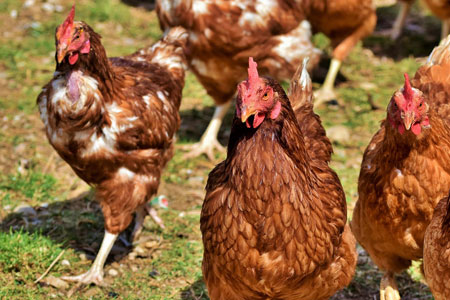
Molting is energy intensive. Chickens therefore don’t normally molt during times when they need dietary energy elsewhere. For example, in the spring roosters use energy for fertility and hens use energy for laying eggs and hatching chicks. In cold weather chickens need energy to keep warm. During a molt, nutrients that otherwise go toward such endeavors instead go toward producing feathers. The sooner a molt is over, the quicker the chicken can get back to business as usual. Here are some ways you can help your chickens through a molt.
Boost Protein
Feathers are 85% protein. Therefore a chicken needs more dietary protein during a molt. Otherwise new feathers may be slow to replace those that shed, a condition known as a hard molt. Further, the newly emerging feathers may be poorly formed.
One way to increase protein is to switch from the usual 16% layer ration to a 20% ration. Where high protein layer ration isn’t available, you could substitute a grower ration.
In fact, when a hen molts after hatching a clutch of chicks, feed her the same starter ration as you feed her chicks. The hen won’t begin laying again just yet, anyway, and could use the extra protein to regrow her feathers.
When chickens are about to molt in the fall, their plumage takes on a dull look. That’s the time to start transitioning to a higher protein ration. A gradual transition is important to avoid digestive upset that would make molting all the more difficult.
Gradually mix the higher protein ration into the new ration over a period of about a week, until the chickens are getting the full 20% protein ration. When the molt is complete and the hens resume laying, gradually transition back to the 16% protein ration.
Animal Protein
Compared to the protein in grains, animal protein is richer in the amino acids a chicken needs during the molt. A little supplemental animal protein therefore will help your chickens through a molt, as well as improve the plumage of show birds. Animal protein may come from any of these sources:
- Mashed scrambled or hard-cooked eggs
- Dried mealworms
- Sprouted alfalfa or sesame seeds
- Fish or fish meal
- High-quality cat food
- Bird molting food from a pet store
During the molt, avoid other types of treats. Chickens that fill up on treats may not get enough protein and other nutrients necessary for feather growth.
Minimize Stress
In addition to being energy intensive, molting is stressful. You can help your chickens through the molt by taking measures to minimize additional stress in their lives.
Avoid unnecessary handling during the molt, when chickens have fewer protective feathers and are therefore more sensitive to the touch. Also make sure they have plenty of space to move around without rubbing against each other, as well as outdoor shade to protect them from sunburn.
Feather Picking
Feathers consist largely of protein. And emerging feathers are filled with blood, another good protein source. So it’s logical that a chicken not receiving enough protein will want to eat feathers.
The newly emerging feathers, or pinfeathers, therefore attract picking. Especially vulnerable are the areas around the tail and along the back.
During a molt, watch for picking and deal with it before it turns into a full-blown case of cannibalism. Make sure you are upping the dietary protein. If necessary, separate the most aggressive picker from the flock.
Keratin Shafts
Each newly emerging feather is covered in a thin sheath of keratin that comes off the pinfeather when the chicken preens. You may not notice these sheaths because they quickly get scratched off by beak or claw. Exceptions are on the chicken’s head and neck, places the bird can’t reach.
Your chickens would appreciate your help removing these hard-to-reach keratin sheaths. Use your fingers to gently scrape off the sheaths in the direction of their growth, or delicately rub the feathers with a damp cloth. Another way to remove keratin shafts is to lightly mist them with a spray of plain warm water, then gently wipe them away with a dry terry cloth.
And that’s today’s news from the Cackle Coop.
Gail Damerow is the author of Storey’s Guide to Raising Chickens.

